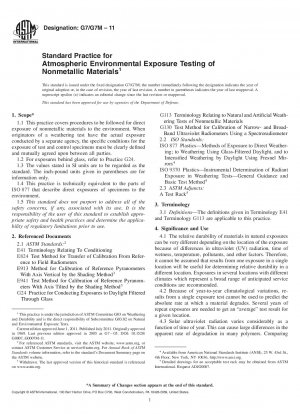ASTM G7/G7M-11
Standard Practice for Atmospheric Environmental Exposure Testing of Nonmetallic Materials
- Standard No.
- ASTM G7/G7M-11
- Release Date
- 2011
- Published By
- American Society for Testing and Materials (ASTM)
- Status
- Replace By
- ASTM G7/G7M-13
- Latest
- ASTM G7/G7M-21
- Scope
The relative durability of materials in natural exposures can be very different depending on the location of the exposure because of differences in ultraviolet (UV) radiation, time of wetness, temperature, pollutants, and other factors. Therefore, it cannot be assumed that results from one exposure in a single location will be useful for determining relative durability in a different location. Exposures in several locations with different climates which represent a broad range of anticipated service conditions are recommended.
Because of year-to-year climatological variations, results from a single exposure test cannot be used to predict the absolute rate at which a material degrades. Several years of repeat exposures are needed to get an “average” test result for a given location.
Solar ultraviolet radiation varies considerably as a function of time of year. This can cause large differences in the apparent rate of degradation in many polymers. Comparing results for materials exposed for short periods (less than one year) is not recommended unless materials are exposed at the same time in the same location.
Defining exposure periods in terms of total solar or solar-ultraviolet radiant energy can reduce variability in results from separate exposures. Solar ultraviolet measurements are typically made using instruments which record broadband UV (for example, 295 to 385 nm) or narrow band UV, as described in 7.2.4 and 7.2.5. An inherent limitation in solar-radiation measurements is that they do not reflect the effects of temperature and moisture, which may also influence the rate or type of degradation.
The design of the exposure rack, the location of the specimen on the exposure rack, and the type or color of adjacent specimens can affect specimen temperature and time of wetness. In order to minimize variability caused by these factors, it is recommended that test specimens, control specimens, and any applicable weathering reference material be placed on a single test panel or on test panels placed adjacent to each other during exposure.
It is strongly recommended that at least one control material be part of any exposure evaluation. When used, the control material shall meet the requirements of Terminology G113, and be of similar composition and construction compared to test specimens. It is preferable to use two control materials, one with relatively good durability and one with relatively poor durability. Unless otherwise specified, use at least two replicate specimens of each test and control material being exposed. Control materials included as part of a test shall be used for the purpose of comparing the performance of test materials relative to the controls.

Note8212;Detailed drawings of this test rack are available from ASTM International, 100 Barr Harbor Dr., W. Conshohocken, PA 19428. Request Adjunct ADJG0007.
FIG. 1 Typical Exposure Rack1.1 This practice covers procedures to be followed for direct exposure of nonmetallic materials to the environment. When originators of a weathering test have the actual exposure conducted by a separate agency, the specific conditions for the exposure of test and control specimens must be clearly defined and mutually agreed upon between all parties.
1.2 For exposures behind glass, refer to Practice G24.
1.3 The values stated in SI units are to be regarded as the standard. The inch-pound units given in parentheses are for information only.
1.4 This pract......
ASTM G7/G7M-11 Referenced Document
- ASTM E41 Terminology Relating to Conditioning
- ASTM E824 Standard Test Method for Transfer of Calibration From Reference to Field Radiometers
- ASTM E913 Standard Method for Calibration of Reference Pyranometers With Axis Vertical by the Shading Method (Withdrawn 2005)
- ASTM E941 Standard Test Method for Calibration of Reference Pyranometers With Axis Tilted by the Shading Method (Withdrawn 2005)
- ASTM G113 Standard Terminology Relating to Natural and Artificial Weathering Tests of Nonmetallic Materials
- ASTM G130 Standard Test Method for Calibration of Narrow- and Broad-Band Ultraviolet Radiometers Using a Spectroradiometer
- ASTM G24 Standard Practice for Conducting Exposures to Daylight Filtered Through Glass
- ISO 877 Plastics - Methods of exposure to direct weathering, to weathering using glass-filtered daylight, and to intensified weathering by daylight using Fresnel mirrors
- ISO 9370 Plastics - Instrumental determination of radiant exposure in weathering tests - General guidance and basic test method
ASTM G7/G7M-11 history
- 2021 ASTM G7/G7M-21 Standard Practice for Natural Weathering of Materials
- 2013 ASTM G7/G7M-13 Standard Practice for Atmospheric Environmental Exposure Testing of Nonmetallic Materials
- 2011 ASTM G7/G7M-11 Standard Practice for Atmospheric Environmental Exposure Testing of Nonmetallic Materials
- 2005 ASTM G7-05 Standard Practice for Atmospheric Environmental Exposure Testing of Nonmetallic Materials
- 1997 ASTM G7-97 Standard Practice for Atmospheric Environmental Exposure Testing of Nonmetallic Materials
